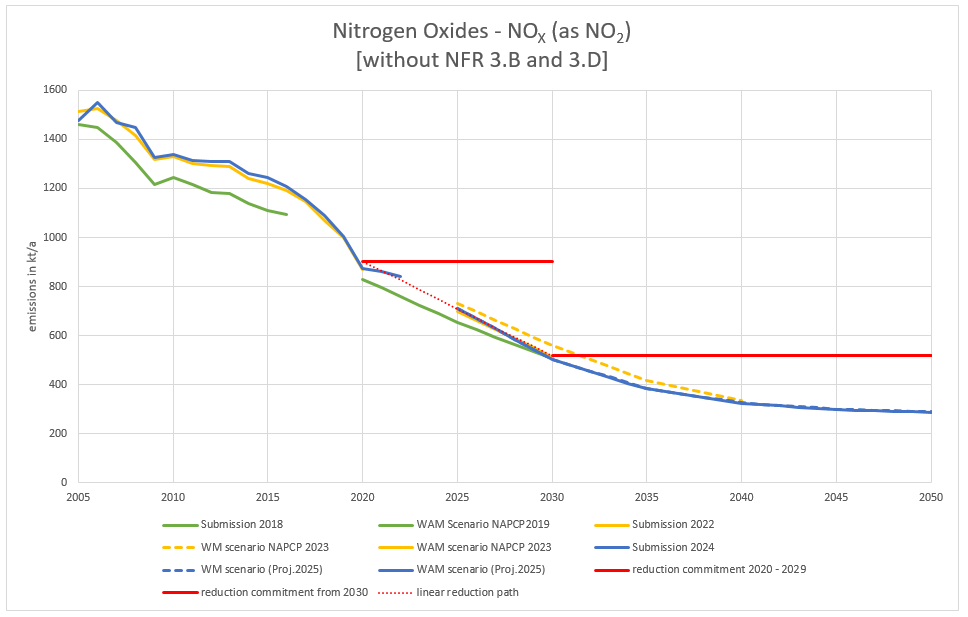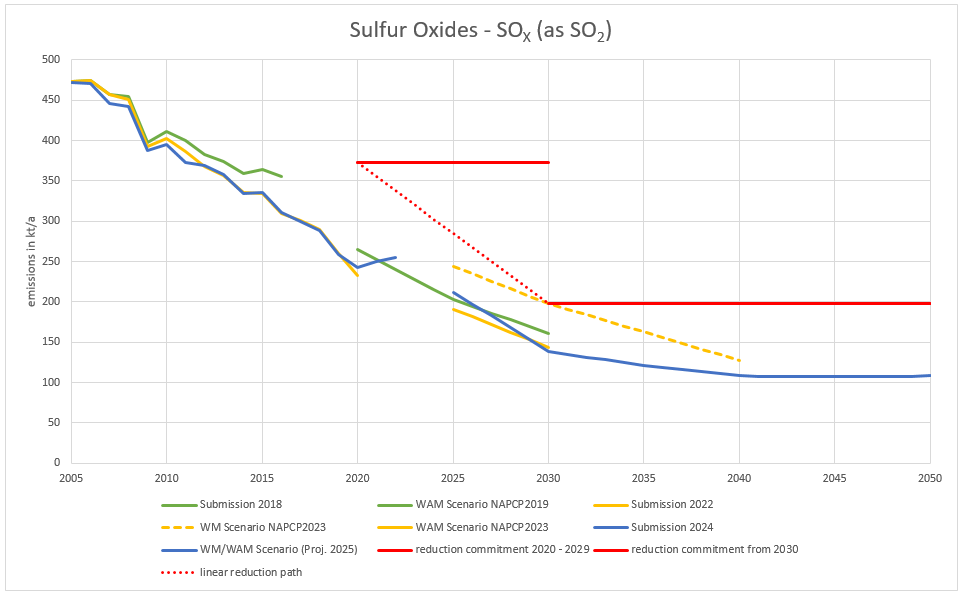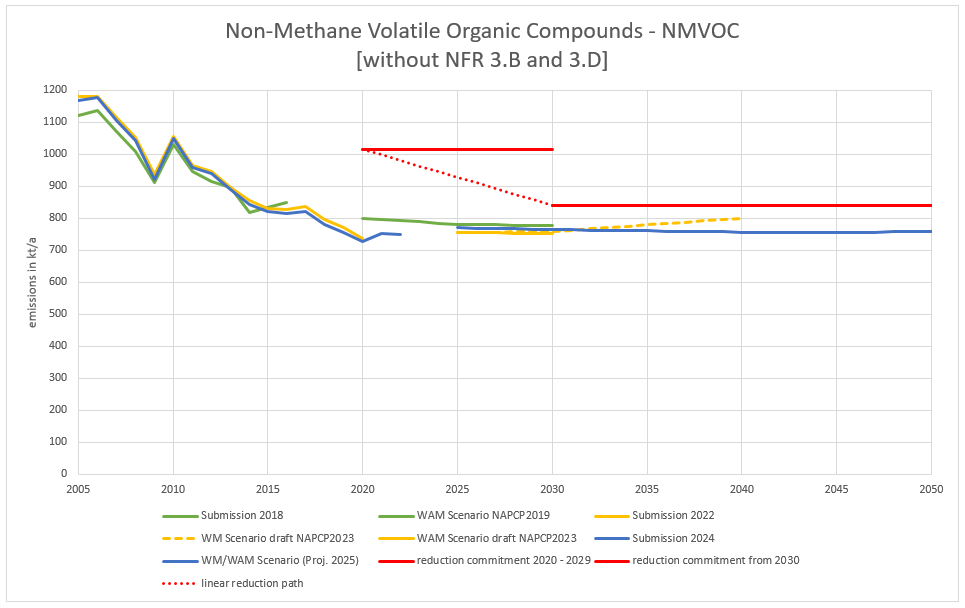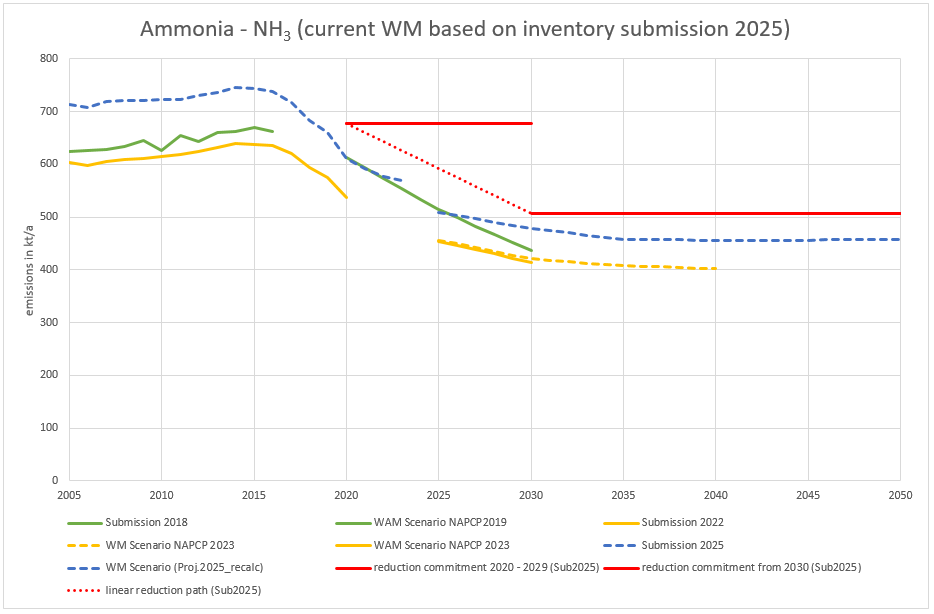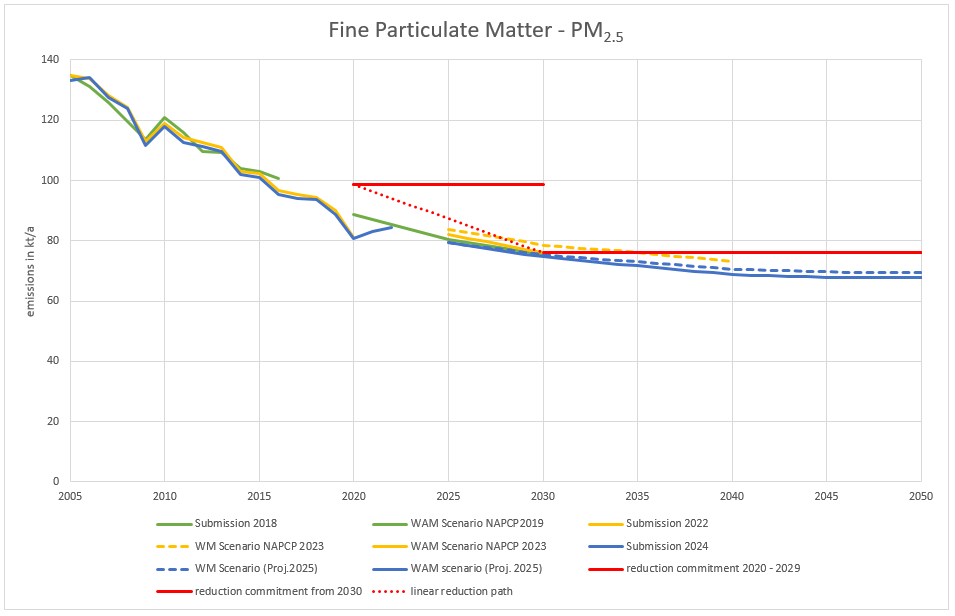meta data for this page
This is an old revision of the document!
Recalculations
 Due to recalculations in each underlying emission inventory submission, all calculations of emission reduction potentials in the WM and WAM scenario of the respective projection are regularly updated. Furthermore, additional measures that had been included in the WAM scenario in the previous projection can become part of the WM scenario in the current projection, as they were put into force in the meantime (e. g. amendment of the 17th BImSchV). In addition, updated GHG emission projections using most recent projections of economic and other parameters result in a new projection of activity rates that needs to be considered for updating the emission projections of air pollutants. For the regular update of the projections under NEC-Directive (EU) 2016/2284, in between the regular update of the National Air Pollution Control Programme every four years, remaining measures in the WAM scenario of the current NAPCP stay and their mitigation potential is reassessed, unless they were dropped by the current federal government. The last is the case for the package of additional agricultural measures in the WAM scenario of the German NAPCP 2023. Thus, it was not reassessed for the current projections.
Due to recalculations in each underlying emission inventory submission, all calculations of emission reduction potentials in the WM and WAM scenario of the respective projection are regularly updated. Furthermore, additional measures that had been included in the WAM scenario in the previous projection can become part of the WM scenario in the current projection, as they were put into force in the meantime (e. g. amendment of the 17th BImSchV). In addition, updated GHG emission projections using most recent projections of economic and other parameters result in a new projection of activity rates that needs to be considered for updating the emission projections of air pollutants. For the regular update of the projections under NEC-Directive (EU) 2016/2284, in between the regular update of the National Air Pollution Control Programme every four years, remaining measures in the WAM scenario of the current NAPCP stay and their mitigation potential is reassessed, unless they were dropped by the current federal government. The last is the case for the package of additional agricultural measures in the WAM scenario of the German NAPCP 2023. Thus, it was not reassessed for the current projections.
For each pollutant the following figures show the differences between inventory submissions 2018, 2022 and 2024 for historic emissions as well as the differences between the WAM emission projections reported in 2019 (consistent with the NAPCP 2019), the WM and WAM scenario reported in 2023 (consistent with the NAPCP 2023) and the current WM and WAM scenario reported in 2025. For each pollutant a brief explanation of the most relevant reasons for the occurring differences compared to the previous reporting is given. For explanation of the differences between reporting in 2023 as well as the NAPCP 2023 reported in 2024 and 2021 please see IIR 20241) and for the differences between reporting in 2021 and 2019 please see the IIR of the 2021 reporting2).
In general, there is not much change in the current projection for NOX, that needs further explanation. Apart from the recalculations in the inventory since submission 2018, explaining most of the differences in 2025 between the NAPCP 2019 projection and the more current projections, there are two relevant reasons for differences between the current WM projection and the previous WM projection of the NAPCP 2023:
- The coal phase-out until 2030 is now included in the WM projection. To some extent because of legislation that did take place in the meantime and to some extent because of updated assumptions on price development of fuels at the energy market as well as for CO2-prices, making especially the power generation from lignite in the remaining capacities less and less economical.
- Second, most measures from the road transport package of the NAPCP 2023 are now part of the WM scenario as they entered into force in the meantime (e. g. amended truck toll, Euro 7 legislation). There is neither further increase of the share of electrically driven mileage for passenger cars nor further increase of the number of passenger cars in the fleet assumed beyond the WM scenario (for description of assumptions in the road transport sector in the current WM scenario see calculation documentation and referred publications).
In general there is also not much change in the current projection for SOX, that needs further explanation. There is only one relevant reason for differences between the current WM projection and the previous WM projection of the NAPCP 2023:
- The coal phase-out until 2030 is now included in the WM projection. To some extent because of legislation that did take place in the meantime and to some extent because of updated assumptions on price development of fuels at the energy market as well as for CO2-prices, making especially the power generation from lignite in the remaining capacities less and less economical. In the WM scenario of the NAPCP 2023 this was assumed to take place until 2038 (see description of the previous WM scenario in the IIR 2024).
NMVOC emission projections are strongly influenced by economic projections. Updates on these are therefore causing changes in NMVOC emission projections. However, the latest historic emissions in 2020 are already below the current projections for 2025 to 2040 in the draft NAPCP 2023, which is caused by decreases over all sectors.
Submission 2021 contained recalculations of NH3 emissions in historic years mainly because of introducing dairy heifers (dairy and slaughter heifers are now treated separately in the inventory) and a methodological change in emission calculations for inorganic fertilisers, leading to significantly lower emissions and less variation from one year to another3). This is the main reason that emission projections of the draft NAPCP 2023 are systematically lower than former projections. As a result, absolute emissions to be reached in 2020 and 2030 following the relative reduction commitments are lower than before. Despite a similar trend in the current emission projections compared to 2021 WAM projection, assumptions of reduction potentials of WM and WAM measures are more conservative now, but compensated by assuming further decreases in animal numbers, especially cattle. This is further explained in the draft NAPCP 2023.
Differences in current projections of fine PM emissions (PM2.5) are a consequence of many factors.
First, recalculations took place in submission 2021 in sector 2.G in the use of fireworks and the use of tobacco4) and in submission 2022 in 1.A.3.d. ii (national navigation)5) leading to lower PM2.5 emissions over all historic years compared to submission 2020. The change in 2005 results in lower absolute emissions to be reached in 2020 and 2030 regarding the relative emission reduction commitments compared to the 2021 projections and further in systematically lower projections based on submission 2022 compared to 2021 projections. Still, the WM scenario of the draft NAPCP 2023 is above the WAM scenario of the NAPCP 2019 because of the same reason as in 2021 projection (more conservative methodology to project activity rates in certain industrial sectors)6). Finally, the current WAM scenario is compliant with the emission reduction commitment in 2030 due to additional emission reductions through the accelerated coal phase-out by 2030 and the road transport package. Increasing emissions in the building sector due to a projected increase in biomass use can be compensated by additional measures to further reduce the implied emission factors of small combustion installations burning woody biomass. However, if looking at the year 2020 of submission 2022 current WM and WAM scenario are quite conservative due to conservative assumptions over almost all sectors.


